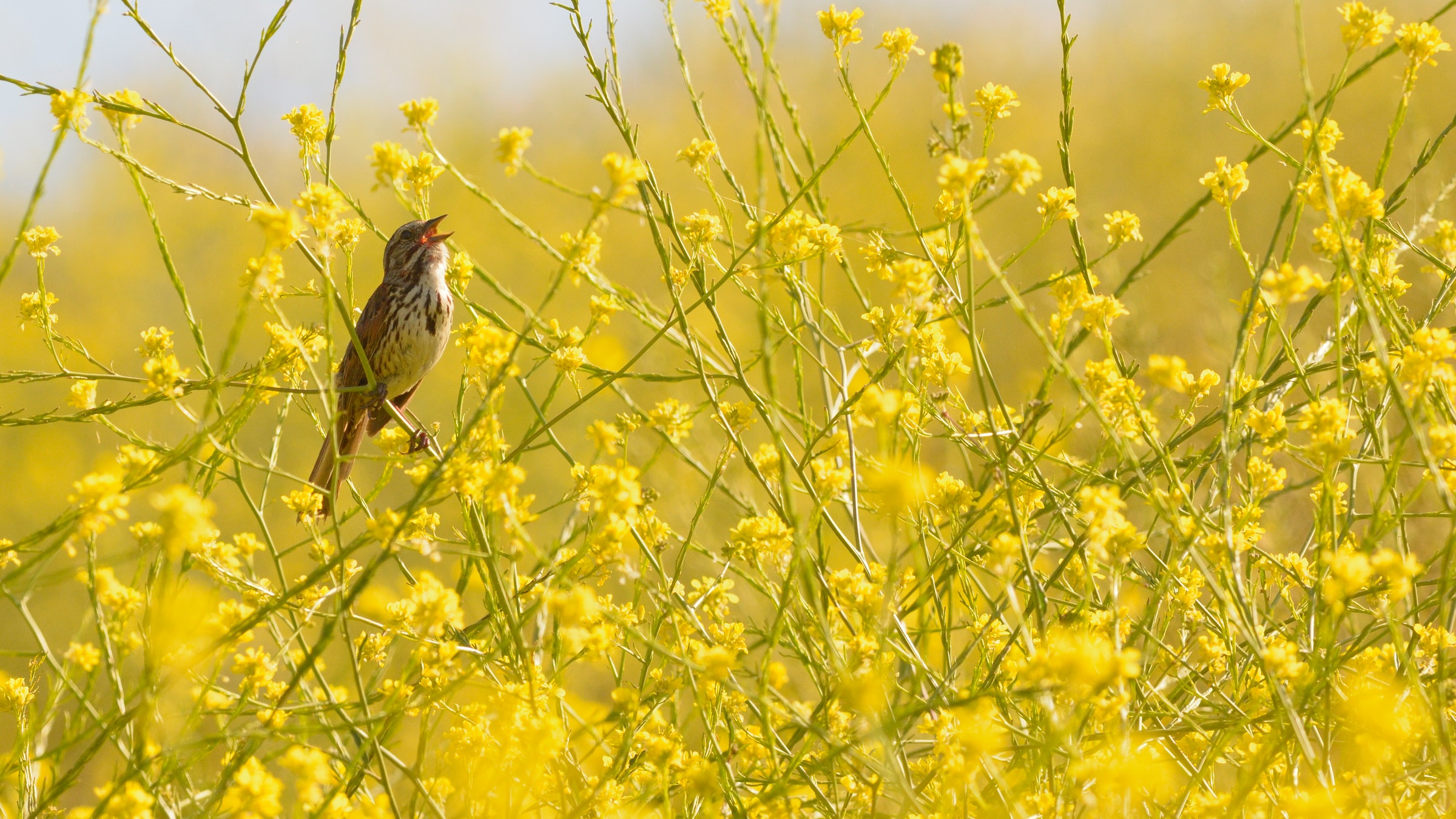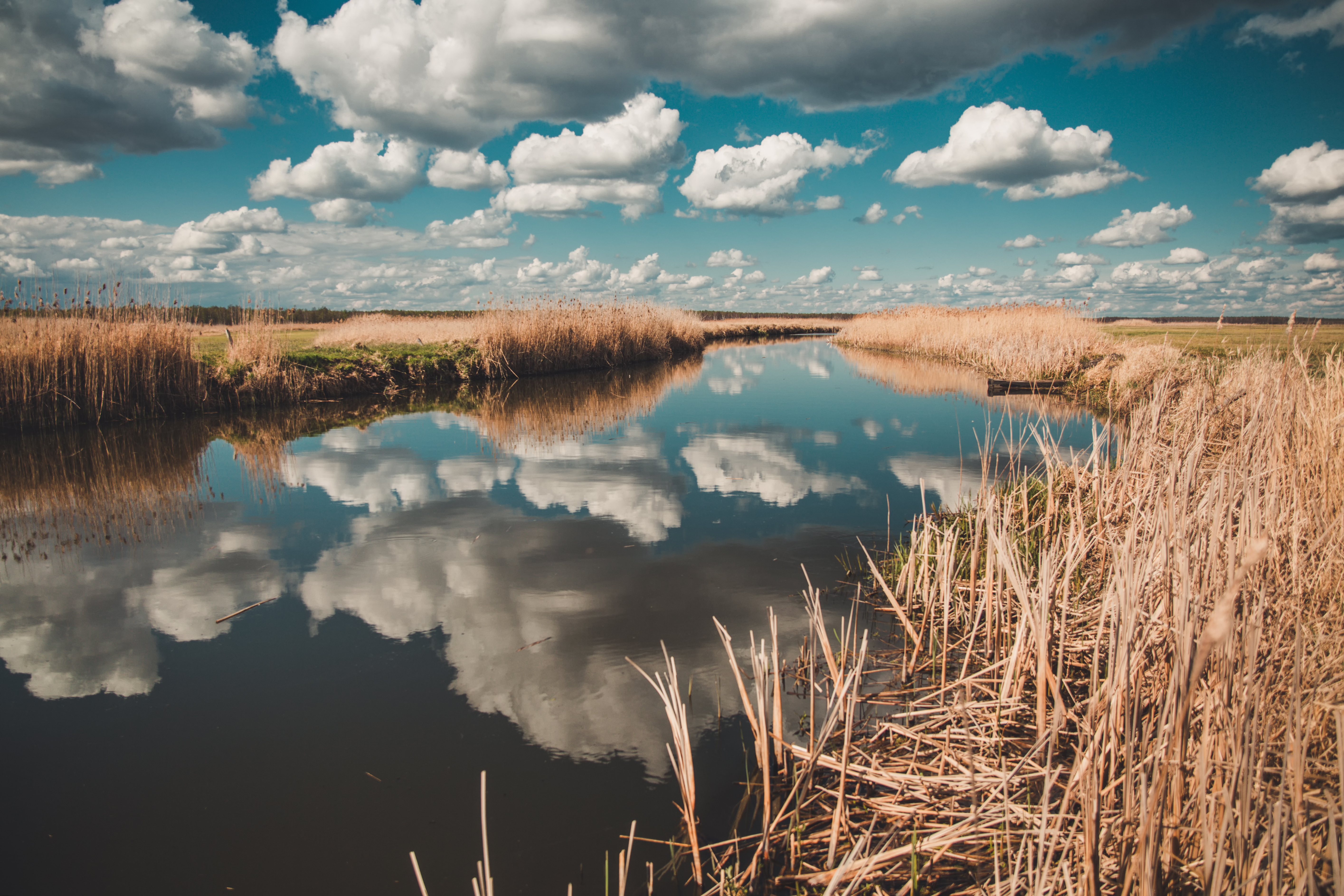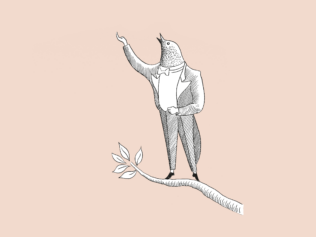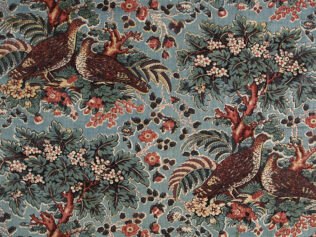
What do the seasons sound like to a naturalist’s ears? Each one sounds different, and spring – a time of avian and batrachian cacophony – has got the nicest sound of all. Winter and summer are not completely devoid of pleasant tones, but it’s in May that true ecstasy can be found.
In the spring, the sounds of nature can be heard everywhere: in fields, forests, meadows and among reeds; in wastelands, woodlands, shrublands, city parks and home gardens. They come from overhead – as flocks of winged wanderers big and small sweep across the sky on their way back from their winter habitats – and from the surface of the water, where birds land to rest or eat.
In the wintertime
Compared with spring, winter is much quieter. Not completely silent as far as the naturalist is concerned, but a season when it is much more difficult to come across sound in nature. The sounds that are there are more subdued, inconspicuous and dispersed. I would compare them to the flecks of sunlight found deep down in the forest in late spring and summer, when a canopy of leaves covers the tree crowns. The specialist term for this is light images; my story, meanwhile, will be about ‘sound images’.
When walking through the forest in winter, I am usually surrounded by silence. Sometimes, if snow happens to be lying on the ground and there is a hard frost, I can hear creaking under my feet. It’s a beautiful sound: cold and sharp, but also atmospheric, soothing and pure. When I am making that sound, however, I have to accept that nothing will come of a chance encounter with a roe deer, red deer or elk. On the other hand, when snow covers the ground, all the tracks can be seen clearly. Needless to say, it is the most mysterious ones that are the most interesting: the trails of a family of wolves, say, who happened to be passing through this spot a few hours earlier. In moments like these, you have the opportunity to use your imagination and try to read the tracks. Were the wolves tracking down a red deer in this area? Or maybe they were patrolling the boundaries of their territory, or seeking to move away from the people working on the logging site? A persevering nature watcher will be able to draw some conclusions from little hints and bits of circumstantial evidence. The sad thing is that snow and severe frost (and hence the creaking underneath one’s boots) are becoming ever rarer. Climate change takes a lot away from the world of natural winter sounds, once so ubiquitous.
As I walk, every now and then I enter a sound image. It is usually the knocking of the great spotted woodpecker. I stop for a moment, and try to spot the dry branch in a pine crown where the woodpecker most likely alighted. Through my binoculars, I can see it working tirelessly on a pine cone that it has placed in a hollow: either a natural one or one it made itself. This hollow is known as a smithy. The smithy is where great spotted woodpeckers (and, occasionally, Syrian woodpeckers) stockpile cones from the area and pick seeds out of them. With time, a substantial pile of husked cones accumulates under the tree. The woodpecker is not particularly timid, so it will usually let itself be watched for a long time. The black woodpecker, however, appears to be a lot more shy: I recognize it by its wistful keeeeaaa sound, which is a bit like the miaowing of a cat. This member of the woodpecker family usually sits on a dead forked pine whose bark has long fallen off, making its smooth greyish trunk and thick branches reminiscent of a fantastical animal straight out of a mediaeval bestiary. When I come closer to the dead pine, the woodpecker immediately flies three trees away from me, changing its call to a hoarse krrreeekrrrreekreeee sound in mid-flight.
When this happens, I move on and often don’t get to hear any more natural sounds during my walk. Occasionally, a roe deer (or a herd of red deer, or a sounder of wild boars) will start, breaking small twigs as they run away into the thicket, and thus making their presence known. The boars make agitated oink sounds, but the deer vanish in complete silence. In the summer, the buck (the male) at least won’t leave without a few barks: its way of letting me know what it really thinks about me. Sometimes, a raven flying overhead will call kraa kraa kraa (it can easily spot me through the sparse tree crowns); alternatively, I will hear the bellowing of bullfinches with their quiet pew-pew-pew call; or siskins, chatting to each other in a mixture of tilu and tluiyh sounds. The jip-jip-jip of the red crossbill is far less common. If I come across these birds several times during my walk, it’s a sign that there’s been a dearth of spruce seeds up north. In the event of such a shortage, crossbills move further south – at times in such great numbers that their sightings are referred to as irruptions.
Finally, from time to time I walk into a particularly lively image of natural sounds: the winter bosom of tits, goldcrests, Eurasian treecreepers and nuthatches – a true conglomerate of species. These birds dwell high in the tree crowns, where it is hard to distinguish between particular species. One can only tell them apart by their calls –unless I happen to spot a nuthatch descending a tree trunk head first (then I know who I’m dealing with). Contrary to what one might expect, it is not the largest birds that are in charge of these groups. Although they are a lot smaller than nuthatches, tits are far more skilled in detecting danger. Hence the quick, high-pitched, vibrating, emergency trill of the crested tit – burrurret – sends the entire bosom into a state of great agitation. This is not because they’ve spotted me: humans are by no means the greatest threat to their young. The most likely reason for this sudden commotion is that a sparrowhawk flew by or a pygmy owl alighted somewhere in the area. Though modest in size, both species are extremely effective in preying on avian small fry, and hence they spread terror among these birds. Remarkably, tits are capable of conveying in their call information not just about where danger is coming from, but also about the expected size of the attacker. A bird attacking from the air amounts to lethal danger; as for me, the little birds needn’t worry at all. When, after a while, the group calms down, they are back to their usual contact calls, collaborating in spite of their differences.
In the fields and meadows, it’s a similar story. During our walk, we may come across little groups of yellowhammers, chaffinches, bramblings, goldfinches, tree sparrows and greenfinches feeding there; very occasionally, the horned lark, a rare visitor from the north, joins the other birds on the feeding ground. Recently, I have been coming across partridges more and more often; I am pleased about this, as their numbers have decreased significantly over the last few decades. Scared away, the partridges fly off with a vibrating vree call. Their cousins, pheasants, are much more vocal, and cock pheasants boast richly-coloured plumage: an indication of their foreign roots. As they take flight, they beat their wings violently and cut through the air with a whoosh – never failing to supplement it all with a loud croak: kerr-kok. In addition, particularly in western Poland, one can come across boisterous gaggles of tundra bean geese, who often appear alongside (the much less common) bean geese. In recent years, these geese, whose nesting ground is in the far north, have taken to spending their winters in Poland. Today, geese typically appear in stubble fields and fields of green winter crops. These sites are also the feeding ground for both mute and whooper swans (the latter are a lot more common in Poland). As their names suggest, we can distinguish them by their ability to emit sounds – but the sounds themselves differ, too. Mute swans emit nasal snorts, while whoopers make loud trumpeting sounds: a mixture of the honking of geese and the clangour of cranes.
When spring is here…
In the spring, everything changes. It is an exceptional time for a naturalist, especially if they study birds. Sounds can be heard from almost every corner and together they amount to a true cacophony. Crucially, the term should be taken to mean more than the ubiquitous birdsong that can be heard in the early morning, when one species seeks to outperform the chirps of another, by singing louder, faster, earlier or at a higher pitch. Although birds undoubtedly come to the forefront, other animals can be heard, too, and nowhere is this more true than with two of my favourite species: toads and frogs.
Moor frogs are the first to call out: they do so in late March, when the surface of water bodies is often still covered in ice. These frogs call in a quiet, as if subdued, nasal bark; one of their distinctive features is that, during the mating season, the males turn a striking blue. With time, moor frogs are joined by common toads, whose courtship can be observed even in small pools. All day long, toads communicate in their characteristic manner, which brings to mind the high-pitched honking of geese.
At night, it is the turn of the green toads to start their chat: they make a high-pitched, vibrating sound, loud and quick. If our ear is not well-trained, it’s easy to make a mistake – the call of the mole cricket (a dark brown member of the Orthoptera order with huge, spade-like front legs, one of Poland’s largest insects) is quite similar. The call of that insect sounds like a sped-up version of the green toad’s voice. The mole cricket’s emission is unusual, too. It rubs one part of its body against another; specialists refer to this as stridulation.
In warm and dry spots, often at the edges of sparse pine woods or within open spaces, a nightjar can be heard. These broad-billed birds, with large, black beady eyes, have perfected the art of camouflage and are fiendishly difficult to spot in the daytime, but easy to hear at night. Interestingly, the nightjar’s call is similar to that of both the green toad and the mole cricket, albeit its call is less monotonous. This is occasionally complemented with the flapping of the bird’s wings. This sound is easy to remember, being very similar to the sound of a pigeon taking flight. And finally, the voices of other frogs are another part of the nocturnal cacophony; their loud croaking echoing across the areas where marshlands have still been preserved, if only in residual form.
City dwellers who moved to the country to get a taste of bucolic life in the provinces, often complain that the sound of frogs disrupts their sleep. I feel for them, and yet I can’t help but feel depressed knowing that, accustomed to the sound of cars, trams, the sirens of ambulances, police cars and fire engines, the hubbub of human voices and parties, we regard the sounds of nature as alien, even unnatural. Were it not for sealed hotel windows, I myself would often have a hard time falling asleep in these circumstances.
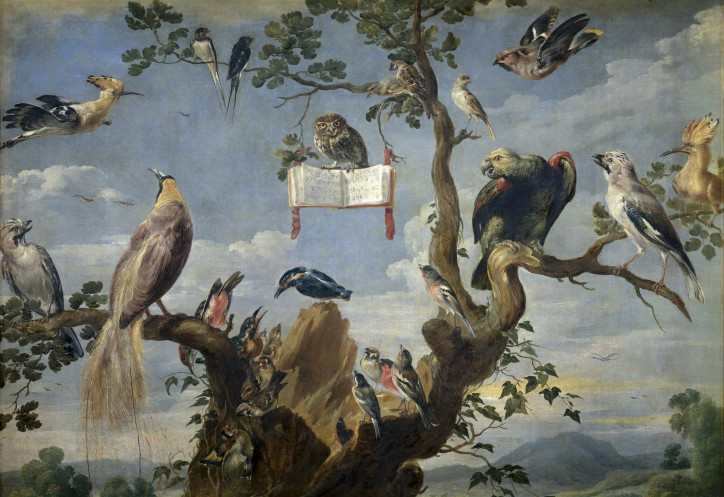
That’s why, although I find it sad, I am not surprised people are bothered by the croaking of frogs, and the croaking of tree frogs. Boy, do they make a racket! In late summer, they are the loudest animals: we can hear them in the evening and at night, when they sing in a choir: repp-repp-repp. If I were to make an inventory of birds whose nocturnal activity falls within May or June (and this includes little crakes, bitterns, little bitterns, water rails), I would face quite a challenge. While the characteristic call of the water rail (which brings to mind the squeal of a frightened pig) is difficult to mistake for anything else, hearing the call of the bittern (which sounds as if it were blowing into a bottle) can be quite a tall order. Not to mention the quiet bark of the little bittern or the quacking of little crakes (to me, the little crake sounds as if it were laughing at someone). These sounds can be particularly difficult to pick up.
Due to the disappearance of marshlands, ponds, and the ever greater impact of chemicals on farming, the voices of frogs and toads, once ubiquitous, are becoming increasingly less common. The fact is that these primaeval sounds are relaxing to our brain! Having frogs and toads nearby has another major advantage: they are extremely efficient in doing away with mosquitoes – or, to be more precise, with the larvae of mosquitoes that reside in shallow bodies of water, where they are food for amphibians.
I know at least two other species capable of making the lives of country dwellers hard. One of them is the epitome of sweetness and inspiration: the nightingale. If you find this hard to believe, try, like me, to fall asleep by an open window near a willow that the nocturnal singer has chosen as his spot. I have the pleasure of hearing the nightingale every spring: to be precise, I listen to the thrush nightingale, whose habitat extends east of the Vistula river; the song of the thrush begins with several sharp, melancholy whistles, which develop into a series of warbles and clatters. The common nightingale (the ‘nightingale proper’, known, among others, from the works of Shakespeare, the inspiration of artists and companion of lovers) calls in a series of shorter stanzas, chirps, flute-like whistles and peals of warbles – all with longer intervals than in the case of the thrush. The song of the common nightingale can be heard in western Poland, although in recent years, reports of the thrush being heard in northeastern regions have become increasingly common. My thrush resides 150 metres from my house, and I can hear it with the window closed. And little wonder, since its song is exceptionally loud: up to 95 decibels from within several metres!
The other bird whose nightly calls are as loud as the nightingale’s is the corncrake: the larger of the two, the crake resides in boggy meadows and brings to mind a tiny dinosaur. It owes its name to its loud and monotonous call: crake–crake. I have spent many a night studying that songbird, but falling asleep when it calls outside the window really is a tall order. As for me, I prefer to focus on the sounds of nature than on the persistence and monotony of that particular sound.
Bird broadcast
Let us return for a moment to the very early spring. Before the sounds of nature explode with the force of an atomic bomb – whose wave will sweep across every nook and cranny, and storm into the most securely sealed homes – the whole thing looks quite innocuous as it gains momentum.
Let us start by looking at open land. As early as February, even if fields and meadows are still covered in snow, the first larks, returning from their winter habitats in western Europe, inaugurate their peal of warbles high above our heads. Initially, they only sing for a brief while, as if timidly. But as the sun gradually becomes bolder, and spring settles for good into fields and meadows, larks, with their characteristic zeal, will carry on signing right until the summer, filling the countryside with their cheerful hubbub. Geese, lapwings and cranes fly in at the same time. To me, the cranes’ characteristic call, the clangour, is the most delightful herald of spring. The attachment binding a pair of these birds into a perfectly synchronized duo eventually makes winter give in. Interestingly, the clangour we hear is the sound of the two birds calling in unison: the greater the attachment between the birds, the more perfect the synchronization.
When the ice melts, marshlands appear, and these in turn begin to fill with aquatic birds. From one day to the next, more and more swans, geese and ducks appear on the surface of the water. Ornithologists jokingly refer to this multi-species mixture as ‘duck soup’. I love that time of year: my telescope to hand, I can stand and look at groups of thousands of birds. Looking out for the rarest ones has long stopped giving me a thrill and today, I am pleased to spot any species I haven’t seen for a long time. My favourites include the cute black-and-white barnacle goose, the short-billed red-breasted goose, the short-necked tundra swan, the thick-nosed common shelduck, the lively smews, the red-eyed red-breasted merganser, the rusty-headed common pochard and the tiny teal.
I find not just observing birds, but also listening to their calls – the ubiquitous quacking and gaggling – extremely rewarding. It’s the wigeons I like best: as they chase the females, they emit a hilarious sound which brings to mind a rubber toy. I like the garganeys, too: their dry rattle sounds exactly like a piece of wood rubbing against a comb. Teals are another favourite, with their clear and high-pitched tril tril whistle. The ‘drawlbilled’ appear alongside many other Aequornithes whose voices keep alternately coming to the foreground in the hubbub of the ‘duck soup’: peewit (lapwings), pi-pe (wood sandpipers), tyu-lu-lu (common redshanks), kyip-kyip-kyip (common greenshanks), kek (black-tailed godwits) and ku-lyi (curlews).
When spring gets into full swing, marshlands of all description become my favourite spots for listening for birds. In the early spring, evenings are a particularly magical time. I would beat myself up were I to miss my annual visit to the Biebrza Valley in northeastern Poland. I begin my tour by searching for the bluethroat – the blue-breasted nightingale – and when it gets dark, I make my way to the wooden footbridge on the Długa Luka trail to listen for an avian sound that pleases the human ear: the bleating of the common snipe. The snipe soars high and then takes a dive, fanning out its tail feathers as it does so. The feathers at both ends of the tail are extremely stiff, which sends them into vibrations, and makes them emit a hoohoohoohoohoohoohoohoo sound, whose impact on the spring marshes is difficult to overestimate. Some male snipes alight on sedge clusters and make the loud chip-per, chip-per, chip-per repeated in quick succession. Occasionally, they are joined by spotted crakes, whose call sounds like falling drops of crystal clear water hueet-hueet-hueet: I can hear them regularly, every second. This is also the time when the aquatic warbler begins to be heard: timidly at first, and then more and more frequently and audaciously. These greyish little birds (smaller than sparrows) attract birdwatchers from all over Western Europe to the Biebrza marshes. I have spent many years counting the singing male warblers in the region, so I am still very fond of their simple call, resembling a rattling laugh. The fact that it can so often be heard in this part of the world is extraordinary: in Europe, warblers are the only globally-endangered songbird species.
There is another sound I associate with the aquatic warbler, one less pleasant to the ear: the buzzing of mosquitoes. Warblers call at dusk and during the night, when mosquitoes are active, too. It’s an unforgettable sensation: struggling through some of Europe’s wildest marshes, taking shortcuts, hopping from one sedge cluster to the next and trying not to lose one’s balance – an effort stymied in no small way by swamp boots, a bare necessity for every lover of marshes. Having finally (and not without difficulty) made it to the agreed stretch of marshland, I begin the process of counting singing aquatic warbler males. Each specimen has to be taken note of and marked on a map. During these stationary seconds, my entire body becomes covered in mosquitoes. It is their buzzing, right next to my ear, however, that is the worst: it annoyed me in May (when I completed my first warbler check) and drove me insane in June (the second check). During that second check, I was covered not only in mosquitoes, but also in sweat, having completed a strenuous route in rubber boots. That is why, were I to point out a characteristic sound of the marshlands, I would mention the bleating of the snipe first, with the unbearable buzzing of the little bloodsuckers a close second.
The eagle-owl, the king of owls, is the highlight of my early spring expedition. For years, I have had one particular spot where I stop to listen for it. The eagle-owl is extremely capricious, not always in the mood to call in its characteristic deep whooo-hooo, repeated about every 10 seconds. There are times when I don’t get to hear it at all, which only motivates me further to return to Biebrza, and for this I remain grateful to the eagle-owl. Usually, when I wait for it, woodcocks fly above my head with their hilarious wart-wart, wart-wart call, ending in a high peeseet squeak that sounds like a rubber toy. But woodcocks can be more easily heard in the backwoods, their typical dwelling place.
For me, woodpeckers are the birds that mark the actual start of spring in the forest. Their drumming echoes throughout the area, the boundaries of the young couple’s territory made known to all within earshot. It is possible to tell a woodpecker’s sex from this sound, or even to distinguish between individual specimens – but that is something I’m unable to do. Actually, no one is, certainly not when listening in the forest. It takes
a specialist computer program for filtering pre-recorded calls. Woodpeckers can be heard all day long and blackbirds begin to call in the evening. Their mellifluous, flute-like song is just as well known to city dwellers – blackbirds appear whenever there are trees – but only in the forest can one appreciate how delightful a blackbird’s song actually is. On a cold March evening, imbued with the smell of wet litter, warmed up by the earliest rays of spring sun, this sound pours into your ears like a balmy stream. This is one of spring’s most magical moments, especially when a woodcock, snoring and crying softly, flies overhead at the same time. Before I get back to my car, abandoned in some forest parking lot, elated by these sounds, I often get to hear the tawny owl, hooting deep in the woods (hoooo hoo hoo hoooooh) – or even the (much less common) boreal owl (poh pooh pooh pooh).
Spring nights in nature are unforgettable to the senses, regardless of where you are. Leaving the house once in a while to experience them is worth your while.
Sounds of the summer
Paradoxically, for a bird lover, the end of spring and the start of summer is one of the sadder periods of the year. The breeding season comes to an end and the avian hubbub gradually dies down. Adult birds tend to keep themselves to themselves – they are looking after their offspring (who by this time have grown a little) and are reluctant to make their whereabouts known. Although the fluffy bunch is by now greater in numbers than when they first returned from their winter habitats, they are more difficult to spot. True, by this point leaves will have appeared. At the same time, though, the population of many species will have increased several fold – after all, a new generation has arrived. Only very occasionally will there be a stir in the thick foliage, a bird will cry or rattle for caution from within a shrub. At times like these, I stop, hoping to spot the one that caused this alarm, but in response it usually falls silent for good, and its presence can only be inferred from leaves, moving as the specimen flees deftly out of my sight. Sometimes, a bill, a wing or an eye will flash – but all this is too little and not long enough for me to tell what species I have come across. In moments like these, I long for the return of spring, when birds are within reach, their voices can be heard from all sides, several species at once, one difficult to distinguish from others. I love spring! It is my favourite time of the year, and my favourite month is May: it is then that the sounds of nature burst out in full force.
Although, actually, I have recently discovered one attractive aspect of summer. For quite a while now, I have been counting young storks in their nests come early July. This is the best time to properly calculate how many there are – by then they are big enough to be seen from the ground. For me, this feels like an extension of spring happiness, and the rattling of the storks will see me through until the following year.



